
© Ennis Physiotherapy Clinic, 3A Barrack Close, Barrack Street, Ennis, Co. Clare V95 X437 Tel: (065) 6840757
Spinal Problems Neck + Back Pain Disc Injury Whiplash Posture
Lower Limb Injuries Walking + Running Ligament Injury Snowsports Injury Home Exs Prog
Upper Limb Injuries Ligament Sprains Tendon+Muscle Golf + Bike Set Up Useful Links

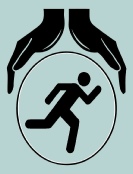


065 6840757

Mon - Fri 9.30am - 8.30pm


3a Barrack Close, Barrack St., Ennis, Co. Clare V95 X437
Tendonopathy is the term currently favoured to describe a range of injuries that affect tendons. It can apply to the acutely injured tendon with associated inflammation – tendonitis – and the more all inclusive dysrepaired and degenerative tendon – tendonosis – which show no sign of inflammatory response. Injured tendons are ‘staged’ on a continuum of progressive deterioration from acutely injured to the worse case scenario where the tendon snaps or ruptures. The most common sites where it occurs are the Achilles tendon (AT) at the ankle, the patellar tendon (PT) at the knee, the supraspinatus tendon and other rotator cuff tendons at the shoulder and the common tendon of the wrist extensors (> flexors) at the elbow - tennis and golfers elbow respectively.
The traditional concept of injury was suggestive of simple mechanical tearing of tendon fibres, leading to an inflammatory response, proliferation of tendon cells and ground substance leading to either full repair + healing, Where full repair did not occur the risk of re-injury was greatly increased. Poor repair or failed repair is called dysrepair and is associated with ongoing or recurring problems.
The model of tendonopathy proposes a progressive deterioration from reactive tendon on initial injury through to tendon dysrepair to degenerative tendon.
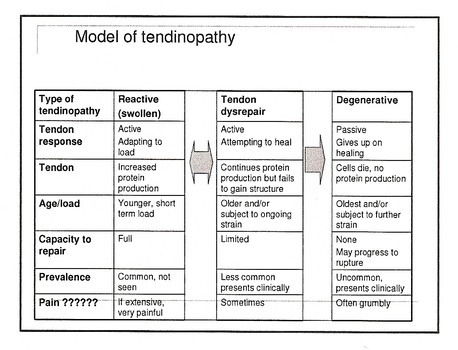
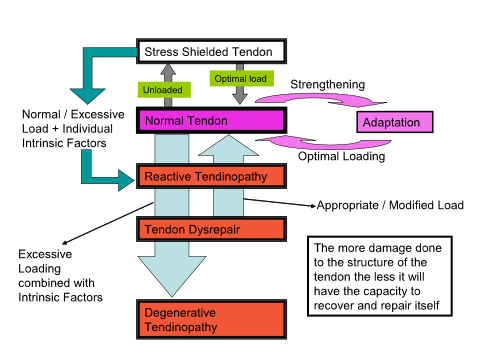
There is now an increasing recognition that tendons react to a variety of factors, some mechanical (external) and some personal (internal) factors. The following is a non-exhaustive list of some of these factors
There are different types of pressures / loading that affect tendons – and that affect may be either Positive or Negative.
1. Tensile – good to maintain fibrous tissue in tendon
2. Compression – good to maintain junction with bone
3. Friction – gliding adjacent tissues / paratendon
4. Combined types – forms and maintains additional bone (spurs)
The normal healthy tendon is easily able to withstand the first 3 of these
but less well able to cope with the last type of stress – activities with the
need to store and then release energy.
Adjusting the loading on the tendon depends on :
- Load type - as above
- Position,
- Muscle length,
- Contraction type - load increases through static, concentric, eccentric
Eccentric load can help to strengthen damaged tendons but is not suitable for reactive tendons.
The Highest Tension Loading occurs where there is
- Eccentric (getting longer as working ) contraction of muscle
- Rapid contraction of muscle
- High resistance / weights being moved by muscle
- Repeated (pre) Stretch – Shorten Cycle in muscle activity
- Application of high loads should be done slowly at first, more quickly later.
- Reduce loading at increased length
- Minimise compression of the injured tendon *by shoes, clothing etc).
High tension loading is more damaging when combined with compression.
Compression alone is least damaging type of loading on tendon.
Long Tendons are prone to overloading in their middle part. Force on the tendon is greater when the muscle is holding a load while stretched.
Short tendons more prone to overloading at the end attachments (insertions)
Tendon pathology is most likely to develops when tendons are exposed to repeated stretch shorten cycles when the muscle tendon complex is already pre-stretched.
Extrinsic Factors
- Training errors
- Time (duration)
- Distance
- Repetitions (intervals)
- Intensity
- Hills
- Surfaces
- Hard Vs soft
- Canted road
- Shoes and equipment
Intrinsic
Age
Female – post menopause
Diabetes
Obesity e
Alignment abnormalities
Foot over Pronation / Supination
Muscle weakness / imbalance
Flexibility
Previous injury (strain, sprain
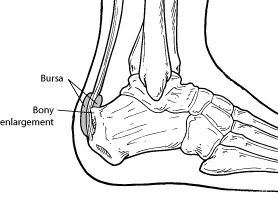
Tendons tissues adapt / respond slowly to rehabilitation.
The tendon needs up to 4 days to respond to training , especially to high loading . Therefore high load training cannot be done daily initially during early rehab (as it could be counter-productive) but must be continued over a prolonged period of time (> 4 weeks). The tendon may become thicker - in an effort to become stronger - but this is normally a response seen in a reactive tendon!
Rehabilitation will depends on:
- The amount of pain arising from the tendon
- The stage of Tendonpathy.
Reactive tendons need to be calmed down
- Avoid eccentric work / loading
- Decrease / alter loading – heel raise, elbow strap
- Manage inflammation symptoms
Dysrepaired Tendons need to be stimulated to restore good structural tissues / normal tendon structure
- Possible concentric and eccentric loading
- Avoiding aggravating factors
Degenerative Tendons need to be stimulated to make the healthy parts of the tendon as strong as possible
- Strengthen the whole muscle tendon complex
- Manage biomechanical loading and internal factors as much as possible.
Rest - where the tendon is relatively unloaded
- Not good for tendons
- No stimulus for protein or structural fibre production
- No maintenance for muscle tendon unit capacity
- No maintenance of musculoskeletal capacity
Adjusting the loading on the tendon
Load type – position, muscle length, contraction type
Eccentric load can strengthen but not for reactive tendons.
Ensure slow / gentle application of load.
Reduce energy storage and release within sessions
2 days between high loads sessions
Reduce loading at increased length
Minimise compression at the attachment to bone
Plan high (strength), Medium (energy storage), Low(power) loading days
Excessive unloading / avoiding load not good either
Previously injured tendons should not be allowed too much ‘time off ‘ training – i.e. off season, rest for other injury etc. These tendons are less able to cope on resumption of normal training and will break down again if not protected by on going training, in order to maintain its load tolerance capacity.
Typically High Load Rehab begins every third day.
To increase the tendons strength apply slightly higher loads than those normally experienced during daily activities on training days. Increase to alternate day training. Aim to move through static loading, concentric (muscle shortening as it works) and finally eccentric (muscle lengthening as it work) loading of the tendon. Back to Top
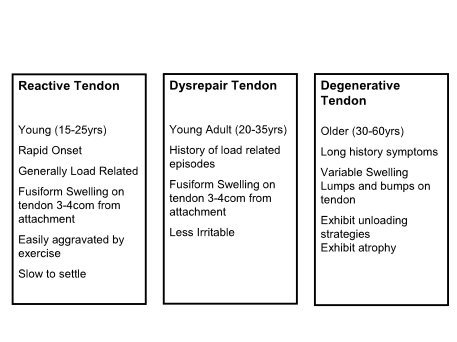
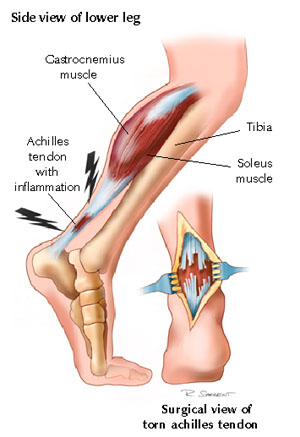
In the video below I would recommend that when doing the exercise shown on the step that one begins by not dropping below the level of the step or indeed begin by doing this exercise standing on the floor before progressing to doing it on a step. Back to Top
Loading on Tendons
Rehabilitation of Tendon Injury
Aims
- Unload the Tendon initially, later manage the loading
- Get Strong – address muscle weakness
- Static / slow tendon loading during early rehab
- Progress speed of activity
- Progress volume of functional activity
- Apply elastic loads in final rehabilitation
1st Stage – Strengthening
0-3 months, Exercises 1 – 2 x daily
Using
- Isometrics / very slow concentric / eccentric contraction
- Sustained loads in inner ROM (30-60 secs x 4-6 reps)
- Avoiding tendon compression
- Progress as tolerated
2nd Stage – Functional Strengthening
2 – 4 months, Exercise on alternate days
Using
- Slow concentric / eccentric contraction
- Moving loads into middle + outer functional ROM
- Increase resistance / load in weightbearing – use speed
- Increased emphasis on eccentric later
- Mostly low and medium loading used
- Build muscle endurance
- Progress as tolerated
3rd Stage – Speed
- Increase speed on every second or third day.
- Speed significantly increases load
- Continue with similar exercise faster
- Control ROM
4th Stage – Athletic Function
2-3 months, Schedule high, load and medium load days
- Increase the speed of loading
- Sport specific activities
- Capacity to absorb repeated elastic loading
- Propulsion activities
- Repeated concentric-eccentric activities (hopping, skipping)
- Acceleration – deceleration, change of direction
The PDF file below is a scholarly paper assessing the the relative benefits of differing loading programmes for rehab of Achilles and patellar tendonopathy in the lower limbs.
Seek coaching advice on
sport technique
- Racquet
- Throwing
- Gripping / paddling
- Running gait
Walking gait - podiatrist
Footwear

Sample Progression of Loading in a Rehabilitation Programme
Coaching - Biomechanics Correction